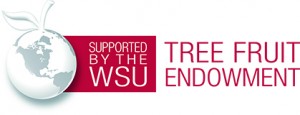Written by Liesl Oeller, Washington State University, August 4, 2025
As apple harvest and storage approaches, it’s important to discuss the role of bin piles as a source of codling moth (CM) populations not predicted by the DAS CM model.
Bins that are brought into the orchard mid-season can harbor overwintering CM larvae from the previous year. Because these CM are transported from outside the orchard, their phenology will not be in sync with the internal orchard population. Therefore, CM adults emerge from bins at different times than predicted by the model.
When do CM colonize bins?
The majority of CM enter the bins when the bins are in the orchard before harvest. CM prefer wood bins to plastic, as there are more crevices to hide in and build hibernacula. These sites can provide overwintering substrates for CM entering diapause as early as June or July.
Monitoring
Extra pheromone-baited traps should be placed around bin piles to monitor moth emergence. Border sprays of 4-5 rows around external sources or bin piles may be necessary if these areas are identified as problems. A good monitoring program can help pinpoint these problem areas so that controls to protect fruit can be applied when necessary.
Prevention
First, using plastic bins for harvest will greatly mitigate bin infestation by codling moths. Second, sterilize bins before they go back out to orchards. While there are no materials registered for spraying bins, bins can be run through a “bin cooker” to sterilize them at the warehouse, before returning to the field. Third, minimize the amount of time bins are in the orchard; do not bring them into the orchard until right before harvest.
Read more about the role of bin piles as a source of CM in this article. For weekly updates on DAS models and tools, subscribe to our mailing list. Now is the perfect time to subscribe to weather stations on DAS, get started today!
Contact
Liesl Oeller
Washington State University
elisabeth.oeller@wsu.edu
(509) 335-5815
Fruit Matters articles may only be republished with prior author permission © Washington State University. Reprint articles with permission must include: Originally published by Washington State Tree Fruit Extension Fruit Matters at treefruit.wsu.edu and a link to the original article.
Use pesticides with care. Apply them only to plants, animals, or sites listed on the labels. When mixing and applying pesticides, follow all label precautions to protect yourself and others around you. It is a violation of the law to disregard label directions. If pesticides are spilled on skin or clothing, remove clothing and wash skin thoroughly. Store pesticides in their original containers and keep them out of the reach of children, pets, and livestock.
YOU ARE REQUIRED BY LAW TO FOLLOW THE LABEL. It is a legal document. Always read the label before using any pesticide. You, the grower, are responsible for safe pesticide use. Trade (brand) names are provided for your reference only. No discrimination is intended, and other pesticides with the same active ingredient may be suitable. No endorsement is implied.

